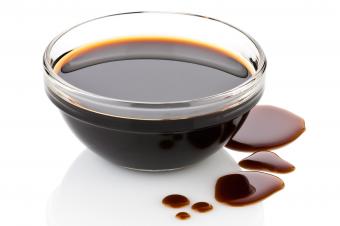
Balsamic vinaigrette dressing has a number of uses outside of just topping a salad. A well-made balsamic vinaigrette can be used to make a number of delicious culinary delights.
About Balsamic
True balsamic is called Balsamico Tradizionale and is traditionally made in the Modena region of Italy. Balsamico is made from wine grapes that are pressed to release their juices. The grape juice is gently cooked down in either copper or stainless steel cauldrons, traditionally over an open flame, and then yeast is introduced to the concentrated grape (called mosto cotto) juice to bring about fermentation (usually taking six to eight months). Once alcohol is present, then aceto-bacteria is introduced in order to convert the alcohol in the mosto cotto to acid.
Once this is done, the aging process begins. The balsamico is transferred to large oak casks with an opening in the top that allows the casks to breathe through a covering of porous cloth. The vinegar is aged in something called a solara system - a series of oak casks decreasing in size in which the vinegar is mixed with previous vintages and further concentrated. This mixing of vintages and aging in smaller and smaller casks brings out the complexity of flavors.
The type of balsamico is determined by how long it is aged. Tradizionale aceto balsamico is aged for a minimum of 12 years. Condimento balsamic is aged three to six years.
Balsamic vinegars not made in Modena are often made in a similar process, although with less aging. There is a wide difference in price and flavor of balsamic vinegars. Balsamic can range from a few dollars a bottle to more than $200 for the long-aged aceto balcamico tradizionale.
For most vinaigrettes, the lower priced balsamic vinegars have a flavor that is just fine when blended with oil, herbs and spices in a vinaigrette. Find a brand that you like and use that. The expensive balsamicos tradizionales are best not blended into vinaigrettes - the flavor stands up on its own without the need for additional ingredients.
Classic Vinaigrette
A classic vinaigrette recipe has a 3:1 ratio of oil to vinegar. Typically, a few tablespoons of fresh herbs and spices are added, as well as sea salt and fresh cracked pepper to taste. All of the ingredients are whisked together. You may also add a few teaspoons of sugar or honey for a sweeter vinaigrette. Using this formula, you can create an unlimited number of vinaigrettes using a variety of oils, vinegars and herbs.
Balsamic Vinaigrette Dressing
Using the aforementioned formula, it is easy to make up your own balsamic vinaigrette dressing. Some suggestions for herbs and spices to add include basil, garlic, shallots and oregano.
Recipe for Balsamic Vinaigrette Dressing
- 3 tablespoons balsamic vinegar
- 1 tablespoon of red wine vinegar
- 2 teaspoons of Dijon mustard
- 2 cloves of garlic, put through a press or finely minced
- 3/4 cup of extra virgin olive oil
- Sea salt and fresh cracked black pepper to taste.
- Whisk together vinegar, mustard and garlic.
- Pour oil into vinegar mixture in a slow stream while whisking constantly.
- Add salt and pepper to taste.
Uses for Balsamic Vinaigrette

There are a number of uses for balsamic vinaigrette. The most common use is, of course, as a dressing for greens. In addition, balsamic vinaigrette is a great marinade for fish or chicken. Fish and shellfish should be marinated in the dressing for 15 to 30 minutes (any longer and the acid will begin to "cook" the fish). Chicken should be marinated for one hour and up to eight hours. The bold flavors of balsamic vinaigrette also go well with beef. Beef can be left in the marinade from four hours to overnight. Vinaigrette in which any raw meat has been marinated should be discarded.
Another excellent use for balsamic vinaigrette is as a dressing for roasted or grilled vegetables. Brush the vegetables with the dressing while cooking, and then toss the vegetables with a small amount of the vinaigrette prior to serving.
A traditional use of extra virgin olive oil and balsamico is as a dip for crusty breads. Balsamic vinaigrette can be used in a similar fashion. Pour it in small, flat dishes and serve with focaccia.
Whether you choose an expensive aceto balsamico tradizionale or one of the less expensive, younger vinegars available at the grocery store, you are sure to discover a delicious flavor that can transform your cooking.







